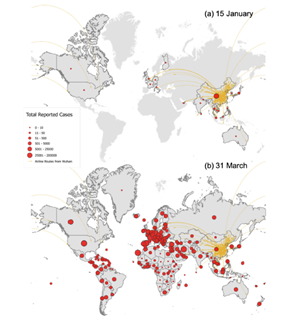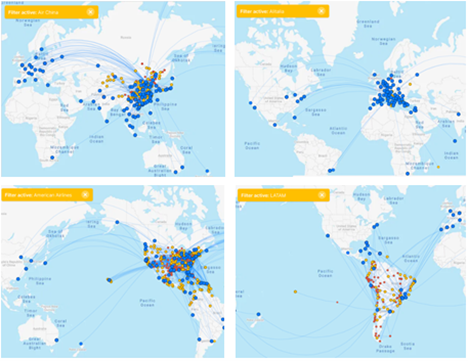FEAR OF COVID-19
The spread of the novel coronavirus, 'SARS-Cov-2', causing the disease 'COVID-19' has resulted in almost one hundred million cases and two million deaths (World Health Organization 2020). While early research suggested that the virus was not as contagious as SARS and MERS, the rapid increase in human to human transmission showed that the virus was in fact more contagious (Chan et al. 2020;Huang et al. 2020;Wang et al. 2020). On January 23, China announced lockdown in Wuhan to limit people’s movement both within and outside Wuhan (Surveillances 2020). This was the starting point to travel and transport restrictions, which were progressively implemented worldwide, following the virus’ expansion (Hamzelou 2020). In the past few months, research has commenced as part of academics’ rapid response to analyse the impacts and anticipate the consequences of the pandemics for tourism and hospitality (see, for example,Gössling, Scott, and Hall 2020). This paper adds texture to this conversation and critically discusses pandemics’ implications for the hospitality and tourism industries concerning the transport sector.
MOBILITY, DISEASE TRANSMISSION AND THE TOURISM INDUSTRY
Catastrophes are sudden tragic events (Posner 2004) which ‘depicts a sudden change in a system’s state’ (Guastello 2013, 29). One thread that is evident in all such events is that human mobility is the means used by a ‘phenomenon’ to spread fast. As human mobility has increased, so has the velocity of pandemic spread and the global community’s concomitant impact. According toFidler (2004), there is a significant relationship between human mobility, globalisation and microbial resilience. Human movement and international trade and travel industries have speeded up the spread of diseases far and wide. The interconnectedness between countries and regions due to the transport network and infrastructure development has facilitated both global trade and tourism industries (Hussain 2019). The intensity of trade and mass travel globally has in the recent past raised global concerns about the outbreak of infectious diseases (World Health Organization, 2016).
COVID-19 emerged in China in 2019. Even though China responded quickly to establish lockdown procedures, the virus travelled far and wide. International spread accelerated and the disease spread in less than two months to over 200 countries and territories (European Centre for Disease Prevention and Control, 2020). In the absence of vaccine and treatment, the only effective method to contain COVID-19 virus was a century-old non-pharmaceutical intervention technique (Baldwin and Weder di Mauro 2020). However, measures are rarely held in place for more than six weeks, and previous research suggested the virus comes back when the measures are lifted (Hatchett, Mecher and Lipsitch 2007). This is also confirmed with COVID-19, since many European countries faced a second wave of cases from September 2020.
Improvement in mobility around the globe appears in parallel to processes of urbanisation, industrialisation, trade and development in global connectivity (Labonté, Mohindra and Schrecker 2011). In this sense, the interconnectivity has increased the rate of pandemic transmission, and because of which twentieth-century already experienced several pandemics (Gössling et al. 2020;Lapointe 2020). An increase in connectivity and mobility speed has significantly reduced the amount of time and effectiveness of measures to contain diseases at micro and macro levels (Brockmann and Helbing 2013;Lapointe 2020). The travel and tourism industry contributed to the worldwide spread of the disease and its vast economic consequences in a dramatic manner (Nicolaides et al. 2020). For instance, the super spreader of the SARS virus, in 2003, was linked to the stay of one person (Dr Liu Jianlun) in Metropole Hotel, in Hong Kong. People who got the virus from him at the hotel travelled internationally, and the infection spread outside mainland China to other places (World Health Organization 2006).

Source:European Centre for Disease Prevention and Control (2020).
Tourism is a significant component of global mobility. With the advancement of technology, the human ability to travel globally has improved consistently over the past 50-60 years with a relatively lower cost (Stephenson 2002). The careful examination of the global travel patterns, specifically air travel, can give us a significant picture of international transportation in the form of aeroplanes. This tells a straightforward story of the spread of disease (see, for example,Walters, Meslé and Hall 2018).Figure 1 almost forecasts the spread of the disease globally outside mainland China by connecting international airline travel routes, observed inFigure 2. Because of the extent of global connectivity, it is harder to contain the spread of pathogens emerged in one part of the world, which rapidly travel to any other side of the globe. In this sense, connectivity (Tourism), not distance per se (Brockmann 2017), is termed as the vector for the spread of the diseases at local, regional, national and international levels directly and indirectly (Gössling et al. 2020;Lapointe 2020). Specifically,Kraemer et al. (2020) argued that the rate of mobility of human being predicts the size of the spread of any epidemic disease, as noted in China.

Source:Flights Connections (2020).
LIVING AND TRAVELLING WITH THE VIRUS
Post-COVID tourism market will be different (see, for example,Lew et al. 2020). The efficiency of countries’ re-opening and the effectivity of implemented measures will determine the success of the re-launching of hospitality and tourism, and the transport industry. This viewpoint has approached the relationships between pandemics and hospitality and tourism from a critical perspective, focusing on ‘human mobility’. COVID-19 is the biggest known global crisis in the recent history of humankind. The crisis has overwhelmed global economies and paralysed local, regional, national and international movements and migrations have questioned current lifestyles, development trajectories and dependencies. Improved connectivity and mobility, extreme tourist velocity, and increased population density have propelled a local health crisis into a global pandemic. As a result, the hospitality and tourism industry has been pushed into a severe recession. Restrictions on human movements and within city lockdowns have raised the question of the resilience of the hospitality and tourism industry and its role as a contributor to sustainability. A critical question that has emerged is whether hospitality and tourism industries can be an effective and sustainable strategy for regional development.
The relationships between health crisis and transport crisis are obvious: both participate in the cause and the consequences. This note debates the role of tourism mobility in the propagation of the virus. Pandemics have further and faster reach as the velocity of travel has increased. Since the introduction of widespread (air) travel from the late 1950s tourism has grown rapidly and unsustainably in some cases. Is tourism good for our health? A new tourism era started, more cautious, more conservative, and more constrained. In this context, a redevelopment of tourism products and experiences is required, which needs significant investments. The post-COVID world requires a holistic exploration of the sustainability aspect of the hospitality and tourism industries. During the last quarter of 2020, transport and tourism were already managed with the first stages of the recovery, travel restrictions were progressively waived in some countries, and the hospitality sector started to adapt to a period where transportation and tourism will need to coexist with the virus. While the tourism industry is ubiquitous and vulnerable, it refers to the one tenth of the global workforce (UNWTO, 2020) and livelihoods look forward to being resilient to face the global crisis derived from uncertain times. When writing this note, in January 2021, a third wave is again hitting many countries worldwide, and travel restrictions are reassured.
Brockmann D.; Helbing D. (2013), "The hidden geometry of complex, network-driven contagion phenomena", Science, Vol. 342, No. 6164, pp. 1337 - 1342. https://doi.org/10.1126/science.124520
Brockmann D. (2017), "Global connectivity and the spread of infectious diseases", Nova Acta Leopoldina, Vol. 419, pp. 129 - 136. http://dx.doi.org/10.25646/2797
Chan J.F.-W.; Yuan S.; Kok K.-H.; To K.K.-W.; Chu H.; Yang J. et al.(2020), "A familial cluster of pneumonia associated with the 2019 novel coronavirus indicating person-to-person transmission: a study of a family cluster", The Lancet, Vol. 395, No. 10223, pp. 514 - 523. https://doi.org/10.1016/S0140-6736(20)30154-9
Flights Connections (2020), Flights Connections, viewed 01 November 2020, https://www.flightconnections.com.
European Centre for Disease Prevention and Control (2020), COVID-19 situation update worldwide, viewed 01 October 2020, https://www.ecdc.europa.eu/en/geographical-distribution-2019-ncov-cases.
Fidler D. (2004), "SARS, Governance and the Globalization of Disease", Springer, Berlin. https://doi.org/10.1057/9780230006263
Gössling S.; Scott D.; Hall C.M. (2020), "Pandemics, tourism and global change: a rapid assessment of COVID-19", Journal of Sustainable Tourism, pp. 1 - 20. https://doi.org/10.1080/09669582.2020.1865387
Hamzelou J. (2020), "World in lockdown", New Scientist, Vol. 245, No. 3275, pp. 7 https://doi.org/10.1016/S0262-4079(20)30611-4
Hatchett R.J.; Mecher C.E.; Lipsitch M. (2007), "Public health interventions and epidemic intensity during the 1918 influenza pandemic", Proceedings of the National Academy of Sciences, Vol. 104, No. 18, pp. 7582 - 7587. https://doi.org/10.1073/pnas.0610941104
Huang C.; Wang Y.; Li X.; Ren L.; Zhao J.; Hu Y. et al.(2020), "Clinical features of patients infected with 2019 novel coronavirus in Wuhan, China", The Lancet, Vol. 395, No. 10223, pp. 497 - 506. https://doi.org/10.1016/S0140-6736(20)30183-5
Kraemer M.U.; Yang C.-H.; Gutierrez B.; Wu C.-H.; Klein B.; Pigott D.M. et al.(2020), "The effect of human mobility and control measures on the COVID-19 epidemic in China", Science, Vol. 368, No. 6490, pp. 493 - 497. https://doi.org/10.1126/science.abb4218
Labonté R.; Mohindra K.; Schrecker T. (2011), "The growing impact of globalization for health and public health practice", Annual Review of Public Health, Vol. 32, pp. 263 - 283. https://doi.org/10.1146/annurev-publhealth-031210-101225
Lapointe D. (2020), "Reconnecting tourism after COVID-19: the paradox of alterity in tourism areas", Tourism Geographies, Vol. 22, No. 3, pp. 633 - 638. https://doi.org/10.1080/14616688.2020.1762115
Lew A.A.; Cheer J.M.; Haywood M.; Brouder P.; Salazar N.B. (2020), "Visions of travel and tourism after the global COVID-19 transformation of 2020", Tourism Geographies, Vol. 22, No. 3, pp. 455 - 466. https://doi.org/10.1080/14616688.2020.1770326
Nicolaides C.; Avraam D.; Cueto‐Felgueroso L.; González M.C.; Juanes R. (2020), "Hand‐hygiene mitigation strategies against global disease spreading through the air transportation network", Risk Analysis, Vol. 40, No. 4, pp. 723 - 740. https://doi.org/10.1111/risa.13438
Posner R.A. (2004), "Catastrophe: risk and response", Oxford University Press, Oxford. https://doi.org/10.1093/oso/9780195178135.001.0001
Stephenson M.. (2002), "Travelling to the ancestral homelands: The aspirations and experiences of a UK Caribbean community", Current Issues in Tourism, Vol. 5, No. 5, pp. 378 - 425. https://doi.org/10.1080/13683500208667932
Surveillances V. (2020), "The epidemiological characteristics of an outbreak of 2019 novel coronavirus diseases (COVID-19) - China, 2020", China CDC Weekly, Vol. 2, No. 8, pp. 113 - 122. https://doi.org/10.46234/ccdcw2020.032
UNWTO (2020), Impact assessment of the COVID-19 outbreak on international tourism, viewed 01 October 2020, https://www.unwto.org/impact-assessment-of-the-covid-19-outbreak-on-international-tourism.
Walters C.E.; Meslé M.M.; Hall I.M. (2018), "Modelling the global spread of diseases: A review of current practice and capability", Epidemics, Vol. 25, pp. 1 - 8. https://doi.org/10.1016/j.epidem.2018.05.007
Wang C.; Horby P.W.; Hayden F.G.; Gao G.F. (2020), "A novel coronavirus outbreak of global health concern", The Lancet, Vol. 395(10223), pp. 470 - 473. https://doi.org/10.1016/S0140-6736(20)30185-9
World Health Organization (2006), SARS: how a global epidemic was stopped, viewed 01 November 2020, https://apps.who.int/iris/bitstream/handle/10665/207501/9290612134_eng.pdf?sequence=1&isAllowed=y.
World Health Organization (2016), An R & D Blueprint for Action to Prevent Epidemics, viewed 01 October 2020, https://www.who.int/publications/m/item/an-r-d-blueprint-for-action-to-prevent-epidemics.
World Health Organization (2020), Coronavirus disease (COVID-19) Pandemic, viewed 01 December 2020, https://www.who.int/emergencies/diseases/novel-coronavirus-2019.
